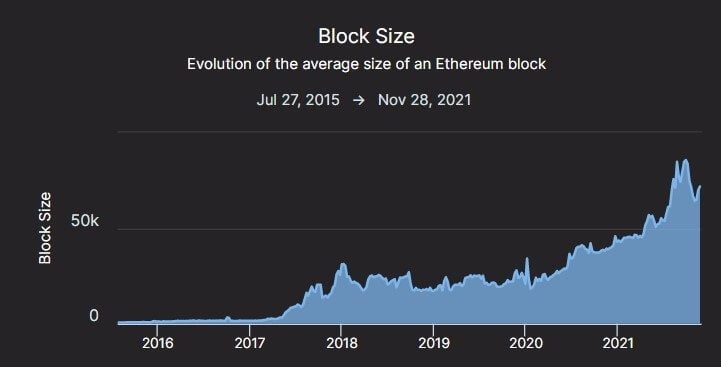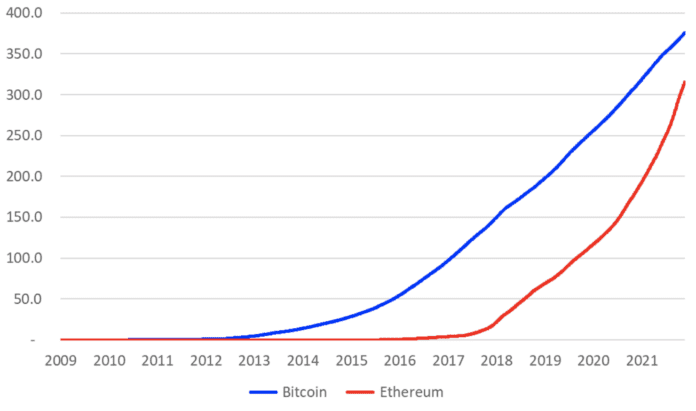Contents
Vitalik Buterin has shown an insistent attitude in trying to solve the issue of high fees in Ethereum.
In Short
- The proposal would allow handling more transactions per block in Ethereum.
- The amount of gas represented by the computational effort limits the block size.
- Ethereum’s blockchain currently weighs 318 GB, close to Bitcoin’s mark.
Bigger Ethereum Blocks: Buterin’s new proposal. Ethereum co-creator suggested a new Ethereum Improvement Proposal (EIP) to increase the block size to 1 megabyte (Mb). Ethereum needs to find a solution for the high fees on this network specialized in Smart Contracts in the short or medium term.
EIP-4488, currently under discussion, was published last November 23 on GitHub. The motivation for the increase in block size focuses on making greater use of rollups or second-layer solutions. Buterin said they could reduce up to eight times the current fees. The new EIP will arrive before Ethereum 2.0.
Blocks in Ethereum are now restricted simply by the total quantity of gas generated by each transaction. Gas measures the computational cost required for a miner to validate a transaction. Currently, the maximum amount of gas per block is 12,500,000. Miner’s agreements set the gas price, determining whether to raise or lower it based on demand. One particular transaction on Ethereum – sending ether (ETH) from one wallet to another – typically takes up 21,000 in gas.
According to ETH Gas Station data, at the current cost of $0.17 per 100 units of gas, commissions are around $40. The network uses gas for commissions, while the final payment is in ETH. If approved, the new EIP would change the protocol rules and establish block limits based on a maximum of 1 Mb of data. Historically, the maximum size achieved in an Ethereum block has been 0.08 MB, one-tenth of the size of the new proposal.


Blockchain Speed
Ethereum blocks, with their current size and a mining time of 12 seconds between blocks, can process nearly 15 transactions per second (TPS), according to Blockchair data. An increase in block size could mean an increase in TPS. Rollup developments currently handle many more TPS than the main Ethereum network processes. ZkSync 2.0 promises, when the network activates it, to process more than 20,000 TPS.
Increasing Ethereum’s block size would allow more room for this second-layer solution since there is more space for processing rollup information. However, the increase would not be easy. Mining a block every 12 seconds with a weight of 1 Mb would mean that the blockchain would grow three terabytes per year or, according to Buterin, one terabyte per year in more favorable scenarios. Blockchain size could pose a challenge for new nodes connecting to the network and needing to audit such amounts of data.
The EIP is being debated and is still some time away from approval. However, as demonstrated in the proposal’s discussion thread, several developers have given their thumbs up to this enhancement for Ethereum. If accepted, it’s unclear how this EIP would be implemented on Ethereum, as it might be a hard or soft fork.
High fees: Ethereum’s headache
Ethereum has been suffering from rather complicated network congestion for some time now. With the rise of DeFi, NFTs, and P2E gaming, the network suffers from spikes in fees, leaving users to pay, at times, as much as $65 or more in fees, according to BitInfoCharts data.
Second-layer solutions appear to be the answer. Ethereum rollups and sidechains currently host many decentralized applications (dApps) in the quest for better network fees. For example, current rates on Ethereum are, on average, above $40, while rollups, such as Optimism, are in the $3.62 range.
Bets are on the arrival of Ethereum 2.0 and the change in consensus protocol from PoW to PoS. However, developers must achieve a short to medium-term solution to the commission issue.
Ethereum’s blockchain weight is close to surpassing Bitcoin’s
Ethereum’s (ETH) blockchain is close to matching and possibly exceeding the weight of Bitcoin’s (BTC), which, although still the largest, seems to be outpaced by the growth of the Ethereum network.
According to BitMEX Research, the analysis arm of the cryptocurrency exchange, the Bitcoin blockchain is still the biggest, with 380 GB on average. “Ethereum will soon surpass Bitcoin with its rapid appreciation in blockchain size,” they point out. As shown in the following comparative chart:


The graph shows the exponential growth the Bitcoin blockchain has had since 2009. It also shows how Ethereum has been taking the same direction since 2017. BitMEX Research makes a comparison considering the total size of the blockchains.
In the case of Bitcoin, that’s the weight of the software you need to download to run a full node. In the case of Ethereum, it’s the size of the blockchain running an archive node. They both “contain all the transaction data, which must be downloaded from peers to synchronize and verify the chain fully.”
Running a full Bitcoin node is relatively easy. You can set up the blockchain in hours; a home computer has enough computing power. But in Ethereum, running an archive node is a more complicated task. These nodes record all transactions executed on the network, including money transfers, Smart Contracts, and the source code of those contracts. The download can take several days.
Because of all these technical difficulties, not everyone is willing to run an Ethereum archive node. Anyway, it is not something limiting. As in Ethereum, there is also a “typical full node.”, the most commonly used type of node, which records only the already verified transactions of the moment and not the previous ones.
Ethereum “has become a beast.”
Transaction throughput on Ethereum is higher than on Bitcoin, so this network “has lately become a beast, with a high demand for DeFi and NFT-related activities,” suggests BitMEX. Given the tediousness of downloading the entire blockchain from the genesis block, Vitalik Buterin suggests using external protocols to access the oldest parts of the blockchain.
Instead of all archive nodes having to download and serve the entire chain from the source (which involves increasing technical complexity), Ethereum’s protocol would only be responsible for delivering at least a year’s worth of historical blocks. “This can reduce code complexity and node storage requirements, paving the way for further decentralization,” he explained.
Older blocks, transactions, and logs would still be accessible through dedicated subprotocols or externally developed protocols. If implemented, this would alleviate a burden and could, in effect, lead to increased decentralization of Ethereum.
